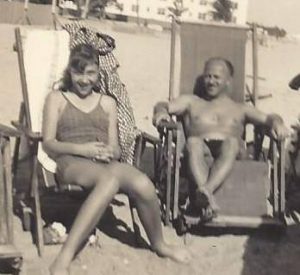The goal of this digital project is to make visible the entirety of Shavelson’s life and activism through curating relevant primary source documents, and combining them with thematic essays that consider the intersections of women’s history, labor unions, consumer activism, family obligations, and electoral politics. Not a biography, this project is a documentary history that explores the traces left by a woman who lived a life of public activism and yet today is little known. Beyond surfacing information about Shavelson, this project aims to be an educational and exploratory tool, as well as a public resource that considers the intersections of organizing, power, and effecting change in New York City.
This project is a master’s capstone by Sarah Brooks Cohn submitted to the Graduate Faculty in Liberal Studies in partial Fulfillment of the requirements for the degree of Master of Arts, The City University of New York.
A special thank you to my adviser, Dr. Cindy Lobel, in whose class I first read about Clara Lemlich Shavelson. To those who provided support and feedback, thank you: Joao Da Silva, Jojo Karlin, Rachel Koroloff, Carol Cohn, Eleanor Mahoney, Jennifer Rutledge, and Leah Anderst.
—
The inspiration for this project came from a course reading of David Von Drehle’s book, Triangle, about the Triangle Shirtwaist Factory fire. It opens with a vivid account of Clara Lemlich leaving the picket line and being beaten by factory-owner-hired thugs. After this point, Lemlich becomes incidental to the story and is mentioned later in the narrative only in passing. From this tantalizing introduction to Clara Lemlich, one of my classmates mentioned that she would like to read a full-length biography of her. I immediately went to WorldCat to see what was out there.
Disappointingly, what I found were two children’s books, a short documentary, and chapters in books about the Jewish-American experience or on the Triangle fire. All of these works focused on her role in the 1909 garment workers’ strike. As far as these books were concerned, her life ended after the strike did. However, one of the books was Annelise Orleck’s Common Sense and a Little Fire, a collective biography of four women, one of whom is Clara Lemlich Shavelson. Orleck provides a proper biography of Shavelson that treats the entirety her life with nuance and generosity, and her book provided the foundational material for this project.
In addition to my academic interest in Shavelson, I also had a personal interest. My father, grandparents, and great-grandparents are all New Yorkers, specifically Brooklynites. My family were Russian Jewish immigrants who came to this country in the late 1800’s and settled in Brighton Beach.
When I first moved to Brooklyn ten years ago, my grandmother, Thelma Brooks Cohn, sent me a list of all of her addresses in Brooklyn and asked me to visit them and take photos for her. The photos sparked a series of reminiscences, and she was always interested to hear how things had changed, and what Brooklyn was like now. This project offered a chance to explore the neighborhood and culture where she spent part of her childhood.
Thelma was the same age as Shavelson’s youngest daughter Rita, and lived with her parents less than 2 blocks from the Shavelson family in Brighton Beach in the 1930s and 40s. Sadly, my grandmother passed away in early 2017, so I never had the opportunity to ask her if she knew, or at least knew of, the Shavelson family.



